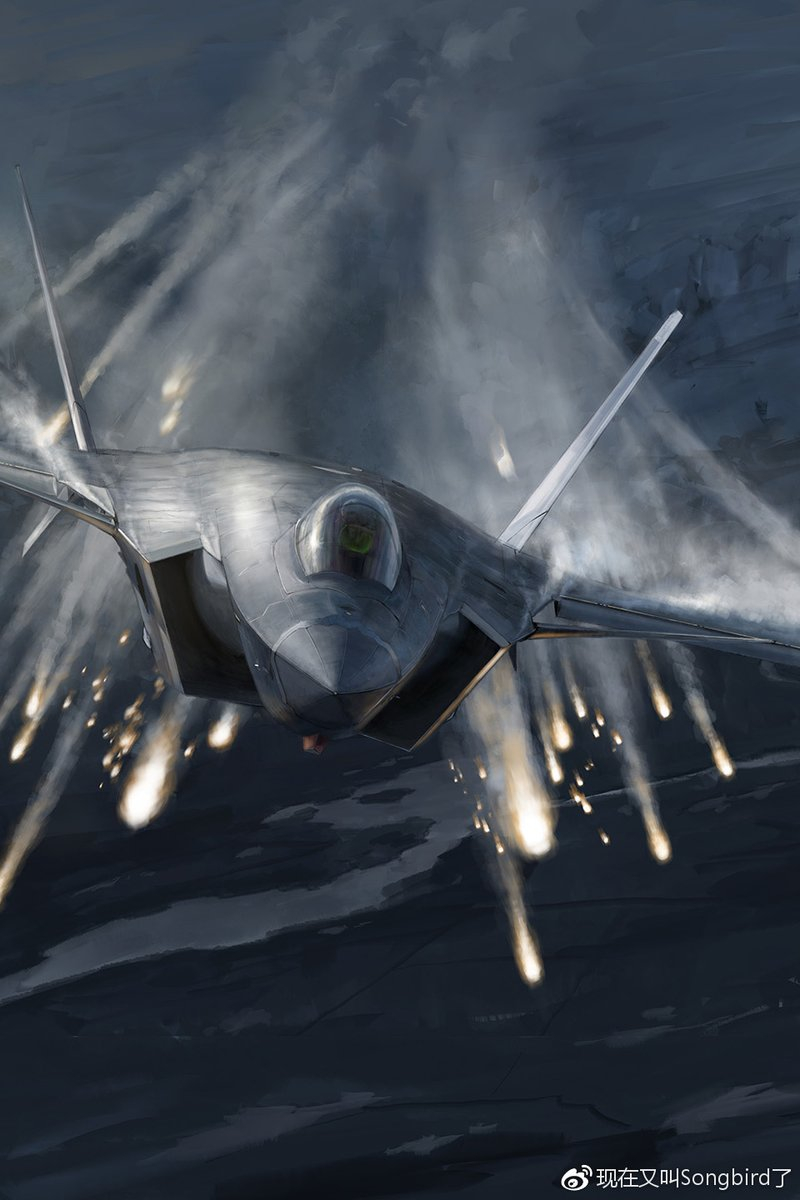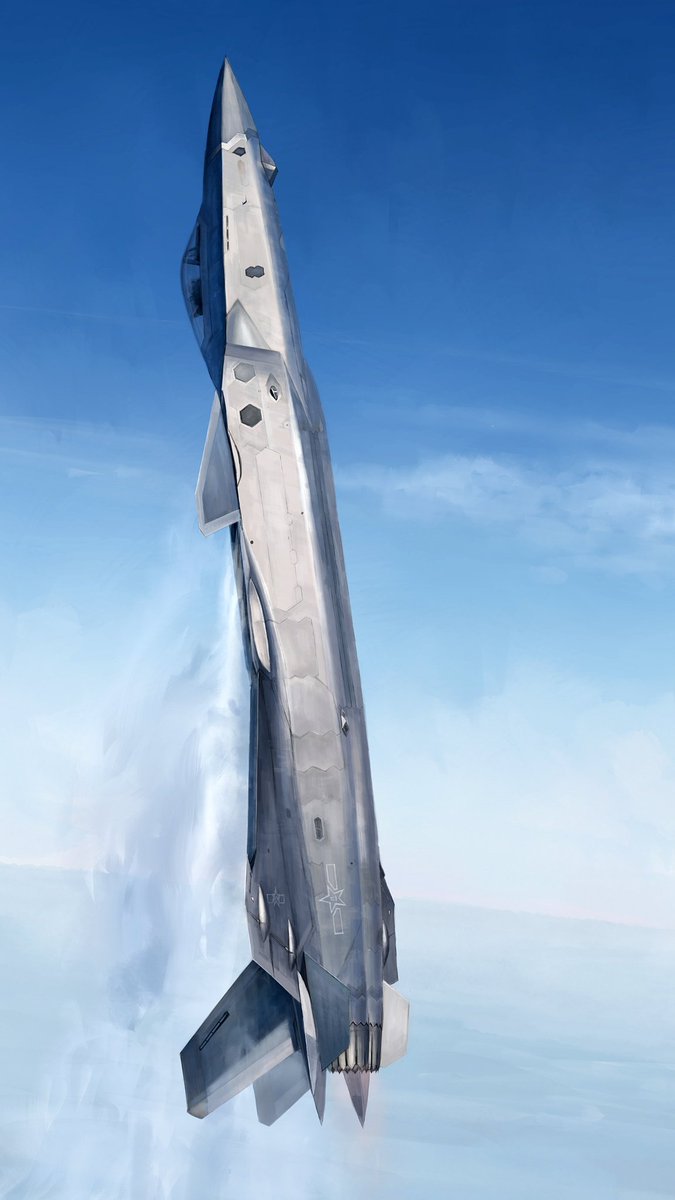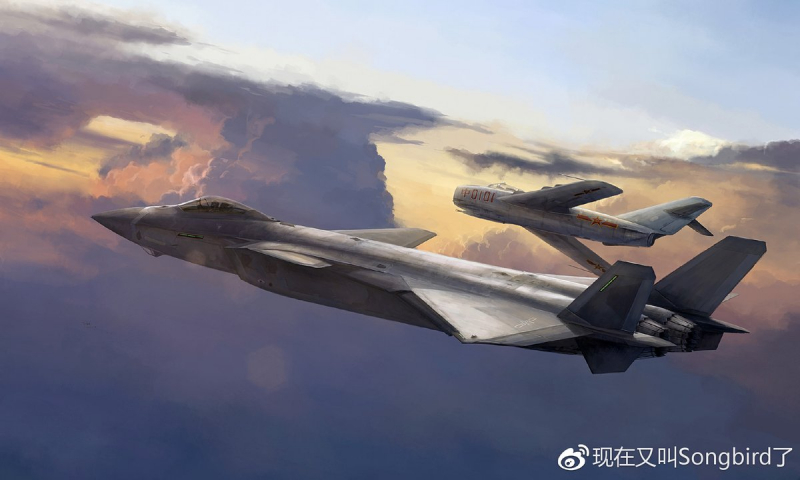You are using an out of date browser. It may not display this or other websites correctly.
You should upgrade or use an alternative browser.
You should upgrade or use an alternative browser.
J-20 5th Gen Fighter Thread VI
- Thread starter siegecrossbow
- Start date
- Status
- Not open for further replies.
Since the J-20 is optimized for supersonic maneuverability, adding TVC will enhance its capabilities in low-altitude and low-speed maneuvers should the situation arise.
thats right, and OVT will enhance aircraft maneuverability at any altitude or any speed,, it may also enhance the L/O aspect of the J-20 by allowing the canards to remain centered in their travel, and pitch trim to be handled by the OVT....
Main purpose of TVC is to use canard less and thus enhance stealth. Read this from super big
The main purpose of OVT is to enhance maneuverability, if programmed into the FCS, it may also be used to trim and even pitch changes, allowing the canards to remain centered, same for the rudder, it may also be used for yaw control...
anyway, I remain a little skeptical, since the J-20's pitch rate is likely pretty healthy in any regard, and while China has been testing OVT for a long time, I believe the Eng was right, and there wasn't a great imperative until those SU-35's showed up?? There's no doubt in my ming that OVT is a great tool, but the US never raced out to put it on the F-15 or F-16, though they had several test bed aircraft proving the effectiveness of OVT.
when the Raptor came along, that all changed, but it is notable that there are NO plans at present, to use OVT on the F-35, even though that is now our most effective A2A platform still in production....
Last edited:
asif iqbal
Lieutenant General
From Dafengcao
J-10B: “Bro, new engine has been tested for you, it feels powerful.” J-20: “Oh, nice! Let me install one first”

But J20 tested the WS-10X before J10B?
Also 2021 is flying with WS-10X for atleast 6 months
J10B could be just expanding the operations for WS-10X
Btw anyone what’s the difference between WS-10X and WS-10B
Also it is confirmed that #2022 is also using WS-10X/B
Hendrik_2000
Lieutenant General
From Henri K blog
Meta-materials and the J-20
BY
It was in his interview at the People's Assembly Palace in front of dozens of journalists that YANG Wei, chief engineer of the J-20 program, spoke quickly about the use of "meta-materials and composites" on the plane. Chinese fighter of last generation.
Without giving any details as to the exact part or parts of the aircraft that benefit from the unusual physical properties of this kind of material whose research is very active today, the "revelation" of YANG generated a lot of enthusiasm and speculation. But what do we really know about this subject?
Les méta-matériaux, développés par les entreprises civiles chinoises, ont été utilisés sur l'avion de chasse J-20. L'information a été annoncée aujourd'hui par son ingénieur en chef YANG Wei à Pékin devant les journalistes.
Long associated with the term of invisibility, thanks to their negative refractive index, meta-materials are macroscopic and three-dimensional composite materials, artificially designed with a periodic architecture. This carefully researched combination then has electromagnetic properties that are not found in a natural material.
We then talk about concrete applications such as invisibility cloak in infrared or visible light, or a radome with negative index to make compact antennas and directives ... etc.
Meta-material studies in China have started since 1989, if not earlier. If we believe in the number of R & D publications made public, which goes from just 200 in 1989 to more than 11,000 in 2014 before falling to fall below the 4,000 mark in 2017, the Chinese focused on applications of these "super-materials", literal translation of 超 材料 in Chinese, in the optical field, electromagnetic, seismic and acoustic.
The number of Chinese R & D publications on meta-materials between 1989 and 2017
The first link that could be established between the meta-materials and the J-20, for its part, dates back to 2017, at least according to the officially published elements. Indeed, we learn that between the 611 Institute AVIC group, design office responsible for the design of the Chinese fighter plane, and the group Kuang Chi (光启), a company Private Chinese founded in 2010 in Shenzhen by five doctors and specializing in meta-material, aerospace and artificial intelligence. The two entities signed an agreement to jointly develop "functional and structural aviation" products (先进 航空 功能 与 结构 产 产))), such as advanced antennas, radar electronics, data link and infrared equipment.
of the "State Key Laboratory of Metamaterial Electromagnetic Modulation Technology", a national laboratory based on Kuang Chi teams and approved by the Chinese Ministry of Science and Technology in 2011. The structure, now employing 23 doctoral graduates, is inaugurated in 2015 before successfully passing the quality audit of the national 863 program in September 2017.
We also learn that the products made in metamaterials have not only been applied on the J-20 but also entered into service within the navy and the force of Chinese rockets, we can cite for example structural parts, windows compliant and specific antennas. The laboratory has also launched new research projects in 2017, such for example.
For now, it's unclear which J-20 elements were made with metamaterials, but Kuang Chi's booth at the last Zhuhai Airshow 2016 probably gave us some guidance. Indeed, one could see for example structural grids, SATCOM antennas, a motor air duct, the wing, the radome with selective stealth and anti-icing panels ... etc.
Meta-materials and the J-20
BY
It was in his interview at the People's Assembly Palace in front of dozens of journalists that YANG Wei, chief engineer of the J-20 program, spoke quickly about the use of "meta-materials and composites" on the plane. Chinese fighter of last generation.
Without giving any details as to the exact part or parts of the aircraft that benefit from the unusual physical properties of this kind of material whose research is very active today, the "revelation" of YANG generated a lot of enthusiasm and speculation. But what do we really know about this subject?
Les méta-matériaux, développés par les entreprises civiles chinoises, ont été utilisés sur l'avion de chasse J-20. L'information a été annoncée aujourd'hui par son ingénieur en chef YANG Wei à Pékin devant les journalistes.
Long associated with the term of invisibility, thanks to their negative refractive index, meta-materials are macroscopic and three-dimensional composite materials, artificially designed with a periodic architecture. This carefully researched combination then has electromagnetic properties that are not found in a natural material.
We then talk about concrete applications such as invisibility cloak in infrared or visible light, or a radome with negative index to make compact antennas and directives ... etc.
Meta-material studies in China have started since 1989, if not earlier. If we believe in the number of R & D publications made public, which goes from just 200 in 1989 to more than 11,000 in 2014 before falling to fall below the 4,000 mark in 2017, the Chinese focused on applications of these "super-materials", literal translation of 超 材料 in Chinese, in the optical field, electromagnetic, seismic and acoustic.
The number of Chinese R & D publications on meta-materials between 1989 and 2017
The first link that could be established between the meta-materials and the J-20, for its part, dates back to 2017, at least according to the officially published elements. Indeed, we learn that between the 611 Institute AVIC group, design office responsible for the design of the Chinese fighter plane, and the group Kuang Chi (光启), a company Private Chinese founded in 2010 in Shenzhen by five doctors and specializing in meta-material, aerospace and artificial intelligence. The two entities signed an agreement to jointly develop "functional and structural aviation" products (先进 航空 功能 与 结构 产 产))), such as advanced antennas, radar electronics, data link and infrared equipment.
of the "State Key Laboratory of Metamaterial Electromagnetic Modulation Technology", a national laboratory based on Kuang Chi teams and approved by the Chinese Ministry of Science and Technology in 2011. The structure, now employing 23 doctoral graduates, is inaugurated in 2015 before successfully passing the quality audit of the national 863 program in September 2017.
We also learn that the products made in metamaterials have not only been applied on the J-20 but also entered into service within the navy and the force of Chinese rockets, we can cite for example structural parts, windows compliant and specific antennas. The laboratory has also launched new research projects in 2017, such for example.
For now, it's unclear which J-20 elements were made with metamaterials, but Kuang Chi's booth at the last Zhuhai Airshow 2016 probably gave us some guidance. Indeed, one could see for example structural grids, SATCOM antennas, a motor air duct, the wing, the radome with selective stealth and anti-icing panels ... etc.
Hendrik_2000
Lieutenant General
(cont)
A radome made of meta-material (Photo: Kuang Chi)
An air duct for an airplane (Photo: Kuang Chi)
Antennas made of meta-material (Photo: Kuang Chi)
An anti-icing board (Photo: Kuang Chi)
An aircraft structure grid made of meta-material (Photo: Kuang Chi)
With announcements of this type that provide a little more detail on the aircraft, and new variants such as the onboard version and the one with Chinese jet engine vector, the program J-20 we probably still reserved other surprises to come.
To be continued.
Henri K.
A radome made of meta-material (Photo: Kuang Chi)
An air duct for an airplane (Photo: Kuang Chi)
Antennas made of meta-material (Photo: Kuang Chi)
An anti-icing board (Photo: Kuang Chi)
An aircraft structure grid made of meta-material (Photo: Kuang Chi)
With announcements of this type that provide a little more detail on the aircraft, and new variants such as the onboard version and the one with Chinese jet engine vector, the program J-20 we probably still reserved other surprises to come.
To be continued.
Henri K.
Main purpose of TVC is to use canard less and thus enhance stealth. Read this from super big
Adding on, the J-20 canards are also relatively large (compared to other 4.5 gen canard fighters) and contributes to overall lift as well.
So the J-20 canards has many tasks, pitch control, contribute lift, modifying airflow over the main wings (when they are close to stalling) etc. and if possible do it all without compromising stealth. Relieving the canards from controlling pitch (by introducing TVC) would help in many aspects.
Letting the canards maintain lift most of the time and relieving it from the responsibility of pitch control could improve rate of turn and stall speed etc, all of which probably is difficult to determine or calculate. The only way to determine it is to actually test it out and it's good that the testing has started.
The number of Chinese R & D publications on meta-materials between 1989 and 2017
I read somewhere that when R&D publications of a certain topic or application drops significantly (the graph above drops sharply after 2015) it is a clue that that particular application has found its way into actual usage.
Has these been posted? Found it after googling #Songbird from the picture Deino posted under Z-20.



We've posted them two weeks ago.
- Status
- Not open for further replies.
